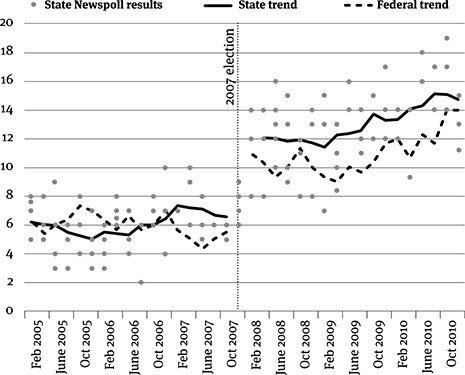ONE of the perpetual debates among Australian election watchers concerns the extent to which federal politics and political issues influence the vote at state level (and vice versa). Did the unpopularity of the Keneally government, for instance, hurt Labor in New South Wales at the federal election last year? Did the Gillard government’s federal struggles influence the Victorian election result that saw Labor defeated in November? Did the veritable army of state Labor governments during the Howard years help or hinder his successive re-election chances?
Some take the Fight Club view – what happens in federal or state politics stays in federal or state politics – while others, particularly the losers of any given election, tend to blame their circumstances on happenings in other political jurisdictions. Unfortunately, the answer nearly always becomes a function of how many electoral angels can dance on the head of a psephological pin. With one exception: something rather amazing happened to public support for the Greens at both state and federal levels immediately after the 2007 federal election.
When we think about the modern-day incarnation of the Greens and their rise to large third-party status, we might be tempted to assume it was a journey of relatively dull incrementalism. Following the party’s debut at 2 per cent of the national vote in 1998, we might think that every year thereafter an additional per cent or so of the population jumped aboard the Bob Brown express, giving us the polling results we see today, with the Greens sitting between 12 and 15 per cent.
While that was true enough in the early years – at least between the 1998 and 2004 elections – over the past five years something much more interesting and rather unusual has happened.
To see what unfolded, we can use Newspoll findings to trace the Greens vote from 2005 onwards at the state government level, average that support to create an “all state” trend line, and compare that with the Greens polling figures at the federal level. As the chart above shows, what we find is an enormous structural break, across both state and federal jurisdictions, at the time of the 2007 election.
It’s worth noting that Newspoll only started specifically referring to the Greens in its voting-intention question just before the 2007 federal election. But as the poll results for the Greens leading up to a given election always fell within a point or two of the actual Greens vote anyway, this change in methodology doesn’t seem to be a meaningful explanation of the sudden jump in support.
It’s hard to believe that just two months before the 2007 election, 6 per cent of the country thought the Greens were an unviable alternative at both the state and federal levels, only to change their minds completely eight weeks later.
More realistically, many among that 6 per cent would have been looking at the Greens as a potential political alternative for a while. The 2007 election result obviously led in some way to a slight perception shift, letting potential support transform into actual support. It was almost as if the 2007 election result unleashed permission for these people to vote for the Greens – as if a substantial part of the population had wanted to, but weren’t quite sure whether or not they were allowed to.
What makes the shift really unusual is that it happened everywhere, at every level of government, over exactly the same short period of time. So it wasn’t just some group that, for example, might have been determined to kick out the Howard government by voting Labor, and then moved across to their more natural home in the Greens – for we saw the same relative numbers of voters behave in an identical fashion in eight quite different political jurisdictions.
The question is not just what that special “something” was that caused the perception shift, but also why it happened exactly when it did. How did the election of a federal Labor government, replacing a long-term conservative incumbent, cause such a significant boost in public support for the Greens both federally and in the states?
Could it be that John Howard was actually holding back the Greens vote, rather than – as many have previously suggested – helping it grow by generating a backlash with his policies on issues from asylum seekers to climate change? Or is it more illuminating to ask why the non-conservative side of politics fractured at both state and federal levels the moment it achieved the top office in the land? •




